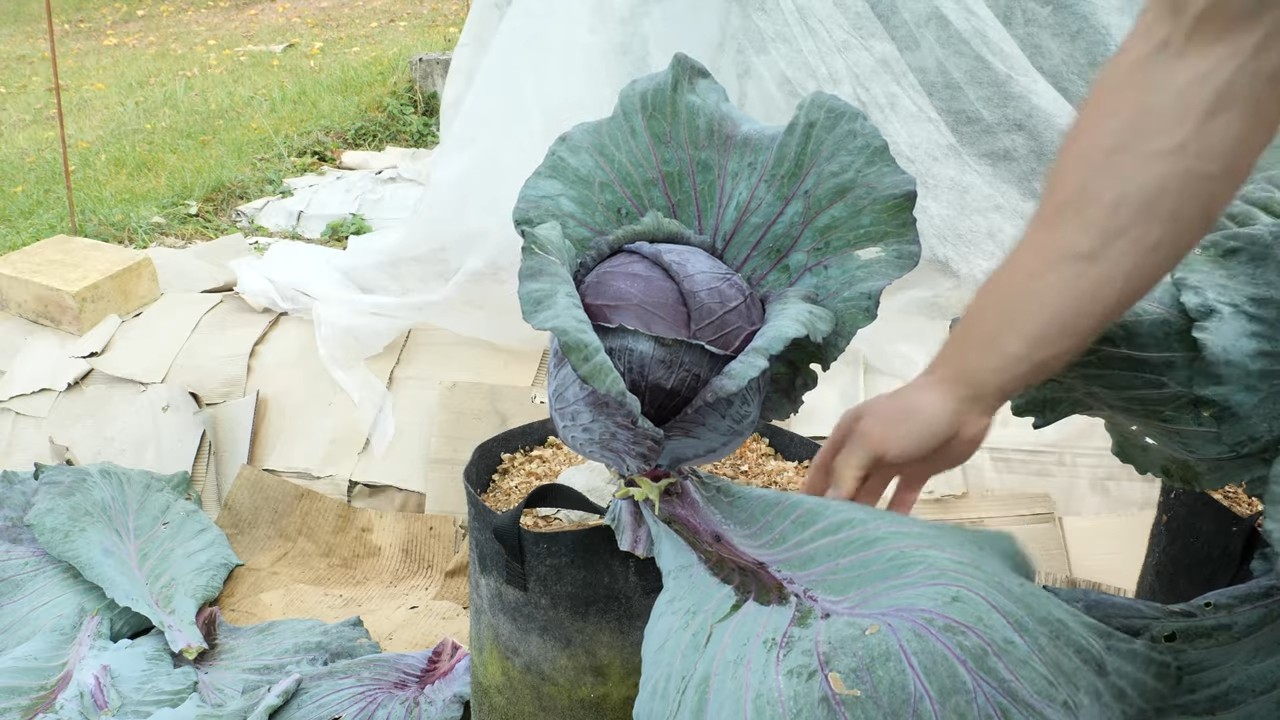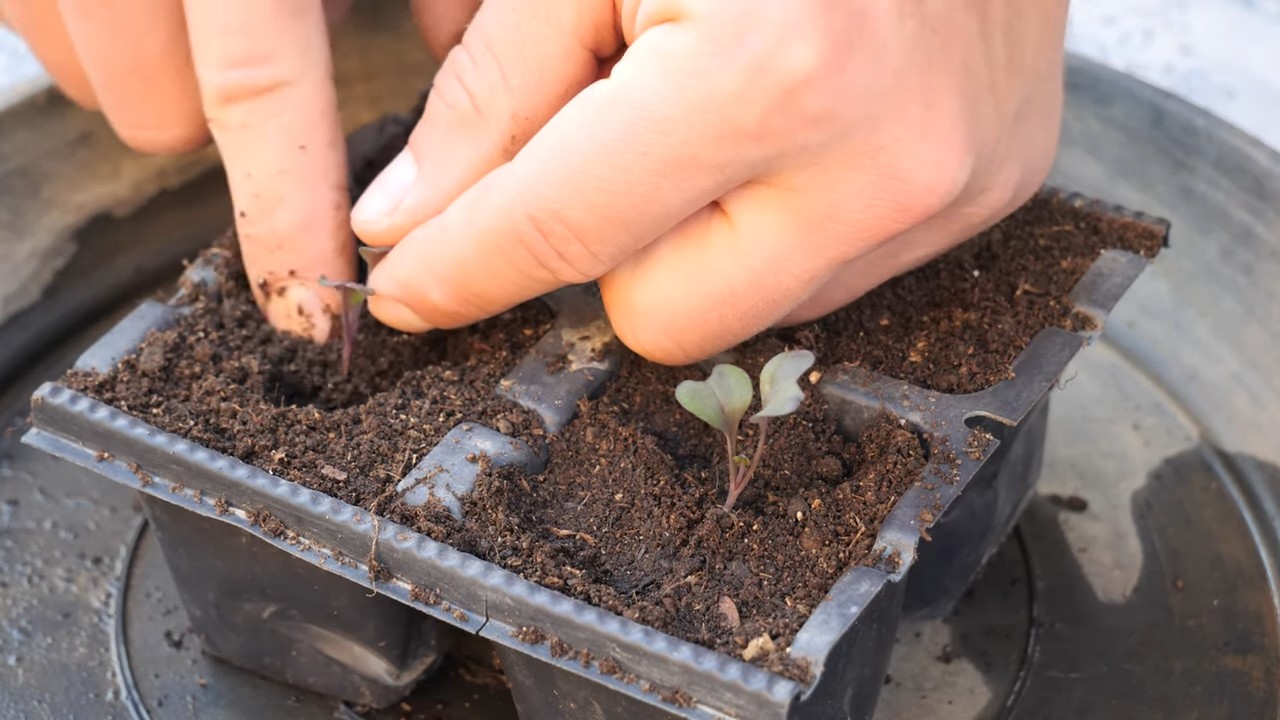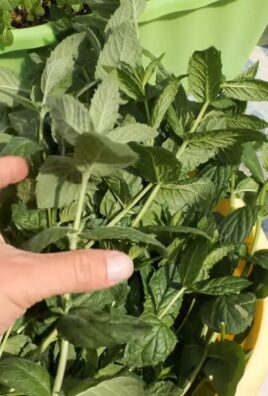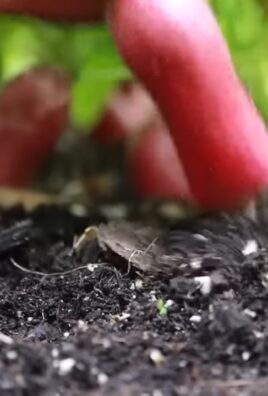Growing Red Cabbage in Pots might sound like a challenge reserved for seasoned gardeners, but trust me, it’s totally achievable – even if you’re a beginner like I once was! Have you ever dreamt of harvesting vibrant, jewel-toned red cabbages right from your own balcony or patio? Imagine the satisfaction of adding homegrown goodness to your salads and slaws, knowing exactly where your food came from.
Cabbage, in general, has a rich history, dating back to ancient times and holding a significant place in various cultures. From being a staple food in Europe to symbolizing prosperity in some traditions, this humble vegetable has nourished generations. Now, we’re bringing it into the modern age, adapting traditional growing methods for urban spaces.
Why should you learn this DIY trick? Well, space is often a premium these days, and not everyone has a sprawling garden. Growing Red Cabbage in Pots allows you to enjoy fresh, organic produce regardless of your living situation. Plus, it’s a fantastic way to connect with nature, reduce your carbon footprint, and save money on groceries. I’m going to share my best tips and tricks to ensure your potted red cabbages thrive, from choosing the right pot size to warding off common pests. Let’s get started and transform your small space into a mini-cabbage patch!

Growing Vibrant Red Cabbage in Pots: A Gardener’s Guide
Hey there, fellow gardening enthusiasts! Ever dreamt of adding a splash of color and a dose of healthy goodness to your homegrown harvest? Well, look no further than the humble red cabbage! Don’t let limited garden space hold you back – growing red cabbage in pots is totally achievable and surprisingly rewarding. I’m here to guide you through the entire process, from seed to vibrant, ruby-red head. Let’s get our hands dirty!
Choosing the Right Pot and Soil
Before we even think about seeds, let’s talk about the foundation of our cabbage kingdom: the pot and the soil.
* Pot Size Matters: Red cabbages need room to spread their roots. I recommend a pot that’s at least 12 inches in diameter and 12 inches deep. A 5-gallon container is a good starting point, but bigger is always better! Remember, the bigger the pot, the more stable the moisture levels will be.
* Drainage is Key: Cabbages hate soggy feet! Make sure your pot has plenty of drainage holes. If it doesn’t, you can easily drill some.
* Soil Selection: Forget using garden soil straight from the ground. It’s often too heavy and doesn’t drain well. Instead, opt for a high-quality potting mix. Look for one that’s specifically formulated for vegetables or contains a good balance of peat moss, perlite, and vermiculite. I personally love adding some compost to my potting mix – it provides extra nutrients and improves drainage.
Starting from Seed (or Seedlings!)
You have two options here: starting your red cabbage from seed or buying seedlings from a nursery. Both are perfectly fine, but I find starting from seed to be more rewarding (and often cheaper!).
* Starting Seeds Indoors (Recommended): This gives you a head start, especially if you live in a cooler climate.
* When to Start: About 6-8 weeks before the last expected frost.
* How to Sow: Fill seed trays or small pots with seed-starting mix. Sow seeds about ¼ inch deep and gently water.
* Warmth and Light: Keep the soil consistently moist and provide warmth (around 70-75°F). A heat mat can be helpful. Once the seedlings emerge, move them under grow lights or to a sunny windowsill.
* Thinning: Once the seedlings have a couple of true leaves, thin them out, leaving only the strongest seedling in each cell or pot.
* Direct Sowing (Warmer Climates): If you live in a warmer climate with a long growing season, you can sow seeds directly into your pots.
* When to Sow: After the last expected frost.
* How to Sow: Sow seeds about ½ inch deep and space them a few inches apart. Once the seedlings emerge, thin them to one plant per pot.
* Buying Seedlings: If you’re short on time or space, buying seedlings is a great option. Choose healthy-looking seedlings with vibrant green leaves and a strong stem.
Transplanting Your Red Cabbage
Whether you started from seed or bought seedlings, the next step is transplanting them into their final pots.
1. Harden Off Seedlings: If you started your seeds indoors, you’ll need to “harden them off” before transplanting. This means gradually exposing them to outdoor conditions over a week or two. Start by placing them outside for an hour or two each day, gradually increasing the time and exposure to sunlight.
2. Prepare the Pot: Fill your chosen pot with your prepared potting mix, leaving a few inches of space at the top.
3. Carefully Remove the Seedling: Gently remove the seedling from its tray or pot, being careful not to damage the roots. If the roots are tightly bound, gently loosen them with your fingers.
4. Plant the Seedling: Dig a hole in the potting mix that’s large enough to accommodate the seedling’s root ball. Place the seedling in the hole and gently backfill with potting mix. Make sure the top of the root ball is level with the soil surface.
5. Water Thoroughly: Water the newly transplanted seedling thoroughly. This will help settle the soil and encourage root growth.
Caring for Your Red Cabbage Plants
Now comes the fun part: nurturing your red cabbage plants and watching them grow!
* Sunlight: Red cabbages need at least 6 hours of sunlight per day. Place your pots in a sunny location.
* Watering: Keep the soil consistently moist, but not soggy. Water deeply whenever the top inch of soil feels dry. Avoid overhead watering, as this can lead to fungal diseases.
* Fertilizing: Red cabbages are heavy feeders. Fertilize them every 2-3 weeks with a balanced liquid fertilizer. You can also side-dress them with compost or aged manure. I like to use a fertilizer that’s high in nitrogen during the early stages of growth to promote leafy growth, and then switch to a fertilizer that’s higher in phosphorus and potassium as the head starts to form.
* Pest Control: Keep an eye out for common cabbage pests like cabbage worms, aphids, and flea beetles.
* Cabbage Worms: These are green caterpillars that can quickly devour your cabbage leaves. Handpicking them off is the easiest solution. You can also use Bacillus thuringiensis (Bt), a natural insecticide that’s effective against cabbage worms.
* Aphids: These tiny insects suck the sap from plants. You can wash them off with a strong stream of water or use insecticidal soap.
* Flea Beetles: These tiny beetles chew small holes in the leaves. Cover your plants with row covers to prevent them from reaching your cabbages.
* Weed Control: Keep the pots free of weeds. Weeds compete with your cabbage plants for nutrients and water.
* Crop Rotation: If you’re growing cabbages in the same pots year after year, consider rotating your crops. This helps prevent soilborne diseases and pests from building up.
Harvesting Your Red Cabbage
The moment you’ve been waiting for! Harvesting your beautiful red cabbage.
1. When to Harvest: Red cabbages are typically ready to harvest in 70-100 days from transplanting. The head should be firm and solid.
2. How to Harvest: Use a sharp knife to cut the cabbage head from the stem. Leave a few outer leaves on the plant, as these can help protect the remaining stem from sunscald.
3. Storage: Red cabbages can be stored in the refrigerator for several weeks. Wrap them tightly in plastic wrap or store them in a plastic bag.
Troubleshooting
Even with the best care, you might encounter some challenges along the way. Here are a few common problems and how to address them:
* Yellowing Leaves: This could be a sign of nutrient deficiency, overwatering, or underwatering. Check the soil moisture and fertilize your plants if needed.
* Stunted Growth: This could be caused by poor soil, lack of sunlight, or pest infestation. Make sure your plants are getting enough sunlight and nutrients, and check for pests.
* Splitting Heads: This is usually caused by inconsistent watering. Try to keep the soil consistently moist, especially as the head is forming.
* Bolting (Premature Flowering): This can be caused by stress, such as extreme temperatures or lack of water. Try to provide consistent care and protect your plants from extreme weather.
Choosing the Right Red Cabbage Variety
There are many different varieties of red cabbage to choose from, each with its own unique characteristics. Here are a few popular options:
* Red Acre: A classic variety with a round, compact head. It’s known for its good storage ability.
* Ruby Ball: A smaller variety with a deep red color. It’s a good choice for smaller gardens or containers.
* Red Express: An early-maturing variety that’s ready to harvest in about 70 days.
* Langedijker Dauer: A late-maturing variety that’s known for its excellent storage ability.
Tips for Success
Here are a few extra tips to help you grow the best red cabbages possible:
* Choose a sunny location: Red cabbages need at least 6 hours of sunlight per day.
* Use high-quality potting mix: This will provide your plants with the nutrients they need to thrive.
* Water regularly: Keep the soil consistently moist, but not soggy.
* Fertilize regularly: Red cabbages are heavy feeders.
* Protect your plants from pests: Keep an eye out for common cabbage pests and take action to control them.
* Harvest at the right time: Harvest your red cabbages when the heads are

Conclusion
So, there you have it! Growing red cabbage in pots isn’t just a gardening project; it’s a gateway to fresher, more flavorful meals and a vibrant splash of color on your patio or balcony. We’ve walked through the entire process, from selecting the right pot and soil to nurturing your seedlings and harvesting your beautiful, homegrown red cabbage.
Why is this DIY trick a must-try? Because it puts you in control. You know exactly what goes into your food, avoiding potentially harmful pesticides and herbicides. You get the satisfaction of nurturing something from seed to table. And, let’s be honest, a homegrown red cabbage just tastes better – sweeter, crisper, and bursting with flavor that store-bought varieties often lack. Plus, the deep purple hue of a freshly harvested red cabbage is a visual treat in itself.
But the benefits don’t stop there. Growing red cabbage in pots is incredibly space-efficient, making it perfect for urban gardeners or anyone with limited outdoor space. It’s also a fantastic way to introduce children to the wonders of gardening and teach them about where their food comes from.
Don’t be afraid to experiment! Try different varieties of red cabbage to find your favorite. Consider companion planting with herbs like rosemary or thyme to deter pests and enhance the flavor of your cabbage. You can also adjust the soil pH to influence the color intensity of your red cabbage – more acidic soil will result in a brighter red, while more alkaline soil will produce a more bluish-purple hue.
Ready to embark on your red cabbage growing adventure? We encourage you to give this DIY trick a try. It’s easier than you might think, and the rewards are well worth the effort. Imagine the delicious slaws, vibrant salads, and hearty braised dishes you can create with your own homegrown red cabbage.
And most importantly, share your experience! We’d love to hear about your successes, challenges, and any tips or tricks you discover along the way. Post photos of your beautiful red cabbages on social media and tag us. Let’s build a community of red cabbage enthusiasts and inspire others to embrace the joy of growing their own food. Growing red cabbage in pots is more than just a gardening project; it’s a step towards a healthier, more sustainable, and more flavorful lifestyle. So, grab your pots, soil, and seeds, and let’s get growing!
Frequently Asked Questions (FAQ)
What is the best size pot for growing red cabbage?
A pot that is at least 12 inches in diameter and 12 inches deep is generally recommended for growing red cabbage. This provides enough space for the roots to develop properly and allows the plant to access sufficient nutrients and water. Larger pots, such as those 14-16 inches in diameter, are even better, especially if you plan to grow multiple red cabbage plants in the same container. The key is to ensure adequate drainage to prevent root rot.
How often should I water my potted red cabbage?
Watering frequency depends on several factors, including the weather, the size of the pot, and the type of soil you’re using. Generally, you should water your red cabbage when the top inch of soil feels dry to the touch. During hot, dry weather, this may mean watering daily, while in cooler, wetter weather, you may only need to water every few days. Avoid overwatering, as this can lead to root rot. Ensure the pot has drainage holes to allow excess water to escape. A good rule of thumb is to water deeply until water drains out of the bottom of the pot.
What type of soil is best for growing red cabbage in pots?
Red cabbage thrives in well-draining, fertile soil that is rich in organic matter. A good potting mix specifically formulated for vegetables is ideal. You can also amend a general-purpose potting mix with compost or well-rotted manure to improve its fertility and drainage. The ideal soil pH for red cabbage is between 6.0 and 7.0. You can test your soil pH using a soil testing kit and adjust it accordingly with lime (to raise the pH) or sulfur (to lower the pH).
How much sunlight does red cabbage need?
Red cabbage requires at least 6 hours of direct sunlight per day to thrive. Choose a sunny location for your potted red cabbage, such as a south-facing balcony or patio. If you live in a particularly hot climate, you may need to provide some afternoon shade to prevent the leaves from scorching. If you don’t have a sunny spot, you can supplement with grow lights.
What are some common pests and diseases that affect red cabbage?
Common pests that affect red cabbage include cabbage worms, aphids, and flea beetles. Cabbage worms can be controlled by handpicking them off the plants or using Bacillus thuringiensis (Bt), a natural insecticide. Aphids can be washed off with a strong stream of water or controlled with insecticidal soap. Flea beetles can be deterred by using row covers or applying diatomaceous earth around the plants. Common diseases that affect red cabbage include clubroot and black rot. Clubroot can be prevented by ensuring good soil drainage and avoiding planting red cabbage in the same spot year after year. Black rot can be prevented by using disease-free seeds and avoiding overhead watering.
How long does it take for red cabbage to mature?
Red cabbage typically takes 70-100 days to mature from seed, depending on the variety and growing conditions. You can start seeds indoors 6-8 weeks before the last expected frost or direct sow them outdoors after the last frost. Transplants will mature faster than direct-sown seeds.
How do I know when my red cabbage is ready to harvest?
Red cabbage is ready to harvest when the head is firm and solid to the touch. The size of the head will vary depending on the variety, but it should be at least 6 inches in diameter. To harvest, simply cut the head off the plant at the base with a sharp knife.
Can I grow red cabbage in containers indoors?
While it’s possible to grow red cabbage indoors, it can be challenging due to the plant’s need for ample sunlight and space. If you want to try growing red cabbage indoors, you’ll need to provide at least 6 hours of direct sunlight per day or supplement with strong grow lights. You’ll also need a large pot and well-draining soil. Be sure to monitor for pests and diseases, as they can spread quickly in an indoor environment.
Can I grow other vegetables in the same pot as red cabbage?
Companion planting can be beneficial for red cabbage. Good companion plants include herbs like rosemary, thyme, and sage, which can help deter pests. Avoid planting red cabbage near other members of the brassica family, such as broccoli, cauliflower, and kale, as they can attract the same pests and diseases.
How can I influence the color of my red cabbage?
The color of red cabbage is influenced by the pH of the soil. More acidic soil (pH below 7) will result in a brighter red color, while more alkaline soil (pH above 7) will produce a more bluish-purple hue. You can adjust the soil pH by adding lime (to raise the pH) or sulfur (to lower the pH). You can also add vinegar to the soil when watering to increase acidity.





Leave a Comment